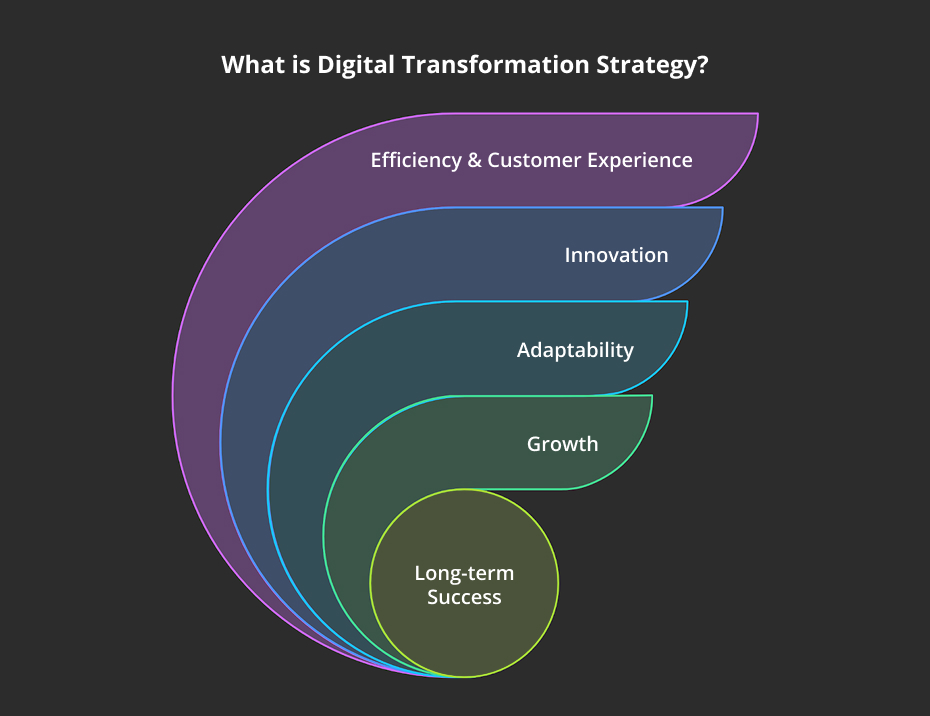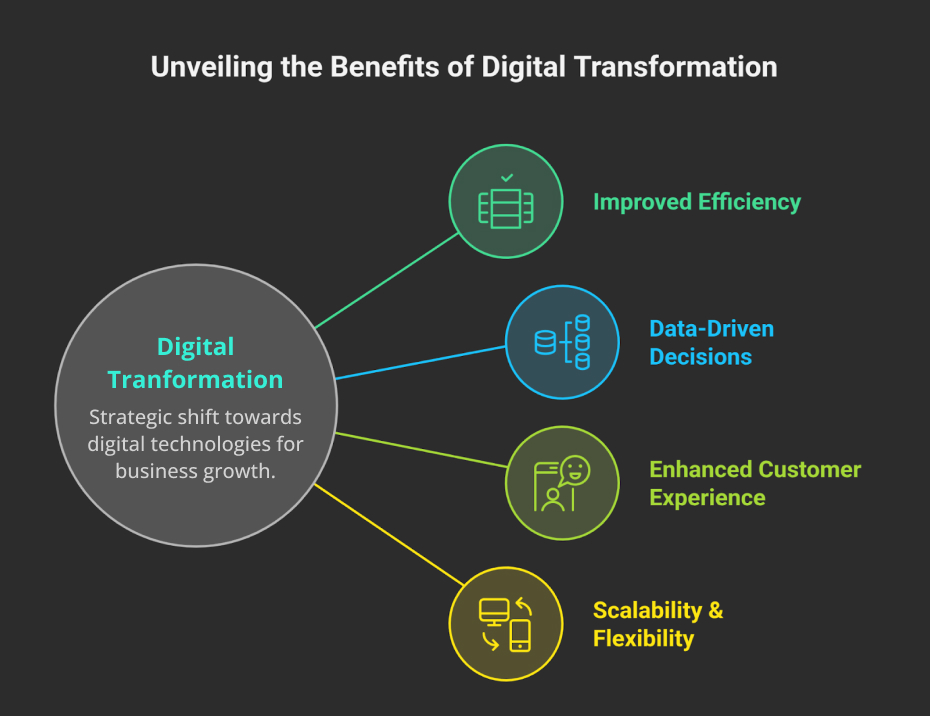The digital shift is not coming, it’s already here. Across industries, digital transformation has become the difference between the companies that lead and those that lag. Reports state that approximately 90% of organizations globally are now going through some form of digital transformation.
But while many companies are quick to adopt new tools or platforms, very few take the time to build a clear and structured digital transformation strategy. Without a well-defined roadmap, transformation efforts can be fragmented, costly, and misaligned with the organization’s real goals.
This blog will help you develop a practical, people-centric strategy for digital technology transformation that aligns with your business goals and delivers long-term value, assisting in purpose-driven growth.
What is a Digital Transformation Strategy?
A digital transformation roadmap is a detailed strategy that covers the entire rewiring of an organization, from technology adoption to cultural shifts. The goal of a digital transformation strategy should be to build a competitive advantage in the market.

A successful IT transformation strategy helps alleviate reliance on manual labor. However, it’s not merely adopting new software; it’s about reshaping your entire business model. This strategy usually involves changes to certain things that help a business:
- To invest in legacy system modernization to stay relevant to present-day needs.
- Improves internal business processes, which reduces overhead costs.
- Introduction of modern technologies for a better customer experience
To guide this process, many companies focus on utilizing digital transformation frameworks as a blueprint for managing change and measuring digital maturity. These frameworks serve as a valuable guide in evaluating your current position, where you want to reach, and how to get there. Thus, making the business transformation strategy more practical and actionable.
Why is a Digital Transformation Strategy Needed?
Staying on top is the ultimate goal of every business, and by embracing digital transformation, over 50% of CEOs reported an increase in revenue. This is just one merit of a successful digital business plan; a structured strategy aids in delivering various benefits alike:

-
Improved Efficiency
Investing in the transformation also improves technology adoption. A modern tech stack facilitates the implementation of project-focused automation. This way, the manual process is reduced, which reduces manual errors and frees up time for strategic initiatives.
-
Data-Driven Decisions
A digital transformation strategy framework involves a structured approach that includes the integration of real-time data analytics. This enables faster, quicker, and smarter decision-making.
-
Enhanced Customer Experience
The integration of real-time analytics significantly enhances the customer experience of your digital solution. This data helps you build personalized digital touchpoints to improve satisfaction and loyalty.
-
Scalability & Flexibility
Platform modernization is a key strategy for transformation. This process is typically complex and requires the presence and expertise of a digital transformation company. They help you replace outdated systems with cloud or modular tools that support the future-proofing of your business.
Businesses that lack a proper digital transformation roadmap stay behind their competitors, who are more digitally mature and customer-centric.
Core Elements of a Successful Digital Transformation Strategy
Digital transformation redefines how organizations operate, compete, and deliver value in a digital-first economy. A digital transformation framework integrates the essential five components of a success-backed change. Here are these:
-
People
The human element is central to transformation because it is people who drive change, adopt new technologies, and adjust processes to ensure success.. The core consists of people, including leaders, employees, stakeholders, and others. Their skills, capabilities, and buy-in are of prime importance.
-
Process
The digital transformation process requires rethinking and improving business processes. Streamlined, agile, and automated workflows help organizations respond more efficiently to changing needs.
-
Technology
The adoption of modern tools and infrastructure enables change. This entails streamlining existing business processes using digital technologies like Robotic Process Automation (RPA) to reduce human intervention and IoT to improve operational decisions.
-
Data
Data drives smart decision-making. Reliable, accessible, and well-governed data allows businesses to personalize experiences and respond intelligently to trends.
-
Customer
Customer expectations continue to evolve. Transformation must align internal capabilities with external needs to deliver better experiences, value, and engagement.
Strategic Approach to Implementing Digital Transformation Strategy
Digital transformation needs a focused and measurable implementation strategy. These three supporting elements help guide organizations from planning to execution.
-
Platforms
The right platforms are essential for enabling digital change. Flexible, cloud-based, and integrated platforms support growth, collaboration, and long-term innovation.
-
Performance
Tracking performance is key to maintaining momentum. Well-defined KPIs and metrics help assess progress and identify areas for improvement.
-
Purpose
Every transformation effort should have a clear purpose. Aligning initiatives with strategic goals ensures that change is meaningful, intentional, and impactful.
Step-by-Step Process for Digital Strategy Development
Once you’ve identified the core transformation elements, the next step is to create a strategy that outlines your every requirement in precise detail. Let’s break down the steps to build a realistic, scalable, and tailored digital business strategy. 
-
Assess Your Current Digital Maturity
The better you know about your digital maturity, the impactful the results will be. Before developing a digital transformation strategy framework, start with the self-audit. This includes where your business stands today in terms of technology, processes, people, and data infrastructure. Outlining
-
Define Clear Business Objectives
After conducting a comprehensive audit of your current digital assets, it is essential to identify and define your business objectives. Technology never leads the strategy, but clear business goals should. Are you aiming to:
- Improve operational efficiency?
- Expand into new markets?
- Reduce costs?
Clearly defined goals will help you prioritize business initiatives and develop an ROI-focused digital transformation plan.
-
Identify Key Technologies
Once you have a clear understanding of the objectives of your digital business transformation strategy, it is crucial to map them to relevant technologies. A few transformative technologies include:
- AI integration for automation
- ML for predictive analytics
- Cloud computing for scalable infrastructure
- IoT for smarter logistics and asset management
- Cybersecurity tools to protect growing digital footprints
Select tools or technologies that seamlessly integrate with your existing solution and scale as needed.
-
Map out the Customer Journey
Your customer expects a seamless, personalized experience. Analyze every touchpoint, from website visitors to service calls, and identify where digital tools can reduce friction or add value. You can utilize the user journey map to find out:
- Bottlenecks
- Drop-off points
- Missed engagement opportunities
-
Build a Cross-Functional Team
To effectively implement your digital transformation strategy, the next step is to establish a cross-functional team. Bring together every department, from IT to Accounts, to form a transformation committee.
-
Create a Digital Roadmap
Once you have mapped the user journey and built a cross-functional team, it is essential to have a digital transformation roadmap that aligns with your specific needs. It must clearly outline:
- Project phases (short, mid, or long-term)
- Budgets and resource allocation
- Key performance indicators (KPIs)
You must break down large objectives into smaller initiatives with clear timelines and assigned owners.
-
Implement and Scale
Now, it’s the implementation stage. However, before implementing it, it is suggested to begin with a pilot program or a Minimum Viable Product (MVP) to test your assumptions. This will help you measure its success, perform iterations, and then scale it across the organization. The best way to adopt this is by staying agile. Technology and markets change, and so should your digital transformation plan.
Is Digital Technology Transformation Strategy Similar for Every Business?
No. However, the core concept of leveraging digital technologies remains consistent; the specific approaches and implementation strategies differ based on the size and structure of a business.
Small Businesses
Their primary focus would be on brand improvement, enhancing customer engagement, establishing a strong online presence, and streamlining their workflow.
- Create accelerated mobile pages to achieve better search engine rankings.
- Invest in building a user-friendly website with mobile optimization.
- Invest in cloud application development for easy accessibility.
Mid-size Businesses
Their core focus would be improving customer experience, gaining valuable insights from data, and automating work processes to increase efficiency.
- They can implement or invest in ERP system integration or CRM development to streamline business operations.
- They can look at the usage of AI in marketing automation for need-based campaign development.
- Invest in custom software development backed by a robust data analytics platform to track key organizational metrics.
Large Enterprises
The core focus of market leaders differs significantly from others when building an enterprise digital transformation strategy. This includes utilizing modern technologies to welcome innovation, optimize complex operations, and foster a data-driven culture.
To adopt digital transformation, the measures they can take are as follows:
- They can opt for an AI consulting company to develop appropriate integrations or solutions.
- They can invest in cybersecurity solutions to protect sensitive user data.
- Can actively implement IoT solutions in automotive to effectively monitor and optimize business operations.
Common Challenges in Implementing Digital Transformation Roadmap & How to Overcome Them?
Even comprehensive strategies can be hindered by roadblocks. Here are a few common issues related to the implementation of the transformation strategy:
- The uncertainty of employees towards the adoption of new technologies and approaches is one of the challenges in implementing a digital tech transformation strategy.
- Overreliance on legacy systems is also a significant roadblock.
- Businesses often take a step back to implement transformation due to a lack of budget.
- Reliance on legacy tech degrades the skills needed to stay current and competitive.
Since every process has a challenge, the subtle nuance is finding the solution that aids in improving the business outcome. This includes
- Involve stakeholders early and communicate the transformation benefits clearly to break down resistance to change.
- Not all at once, but gradually phase out or integrate legacy systems with modern solutions.
- You must prioritize high-impact projects first. It is suggested to consider phased implementation.
- Invest in employees’ training, from AI-first skills to effective grip in cloud migration strategy formation.
Examples of Companies Embracing Digital Transformation
Various companies have showcased that a successful digital transformation can make them the catalysts of change. The key to their success is a deeply connected digital transformation plan that not only empowers technology but also fosters a culture that welcomes change. Here are some notable real-life examples:
Companies | Digital Transformation Elements | Impact |
| Amazon |
| Amazon is a leader in the eCommerce market, offering a superior customer experience. |
| Netflix |
| Netflix has significantly disrupted traditional television and film distribution by popularizing on-demand streaming. |
| Starbucks |
| Starbucks has gained a significant edge among users with a distinctive persona, contributing significantly to its success. |
| IKEA |
| IKEA has helped improve customer experience and sales with a success-focused digital transformation strategy. |
How do you measure the Success of Your Digital Transformation Strategy?
It can be challenging to determine whether your created strategy is working effectively. Without proper tracking metrics that align with your goals, the answer to this question is complicated. You can consider measuring:
- Revenue growth
- Customer retention
- Employee productivity
- Cost savings
- System uptime
- Adoption of new tools
Regular review and feedback loops are vital for continuous improvement. This helps in assessing whether your strategy is effective or requires some adjustments.
Partner With SparxIT for an Expert-led Digital Transformation Strategy
Adopting change positively is necessary for a business to stay sustainable in the market. Digital transformation has been the key driver in recent years, and building a working strategy for its adoption with a skilled company like SparxIT can play a game-changing role for your business. We are a digital transformation company that has been building business-specific strategies for clients over the years.
Our team is the catalyst for change. We know that every organization is different, so we take time to analyze its strengths and weaknesses. This helps us build a clear and compelling roadmap with precision and perfection. We leverage emerging technologies, like AI, blockchain, and IoT, to create innovative solutions that align with current-day needs.
Whether your needs relate to DevOps Automation or building a custom application with blockchain and AI integration, our team helps complete the project you envisioned. You can collaborate on a guided digital transformation consulting project.
Our team has successfully catered to clients across the USA, UK, UAE, and other regions, enabling them to achieve a success-focused digital business transformation. Embrace the change and let SparxIT help you navigate the transformation complexities with expertise.

Partner with Experts
Frequently Asked Questions
How long does it take to implement a digital transformation strategy?










The process can take anywhere from 6 months to over 1 year. Ideally, this depends on the organization's size and complexity, the scope of the transformation, and the maturity of existing systems.
Why does your business require a digital transformation strategy?


















Businesses require a digital transformation plan to achieve effective risk management, remain competitive, reduce overall costs, and accurately predict customer needs.
What are the key steps in developing a digital transformation strategy?


















A winning digital transformation business strategy requires you to follow steps such as assessing your current state, defining a business objective, selecting the right technologies, cultivating a digital culture, developing a strategic roadmap, implementing it, and scaling it.
What are the best digital transformation strategies for small businesses?


















A successful digital transformation roadmap for a small business involves several key elements, including starting small and scalable, and embracing the cloud.
How can you create a digital transformation roadmap?


















As a skilled digital transformation company, we begin by identifying your needs, assessing key areas of transformation, selecting the appropriate technology, developing a digital transformation business roadmap, implementing the plan, and evaluating the IT transformation strategy.
What are the benefits of implementing a digital transformation framework?


















Key benefits of this digital transformation strategy framework include improved clarity, enhanced resource allocation, seamless communication, and a more positive customer experience.
What are the essential elements of a digital transformation strategy framework?


















The key components include customer centricity, data analytics, agile methodologies, and cultural transformation.
What technologies are essential for a successful digital transformation?


















Some essential technologies for a successful digital modernization include cloud computing, Artificial Intelligence, Machine learning, Big data analytics, IoT, automation tools, cybersecurity, and more.




